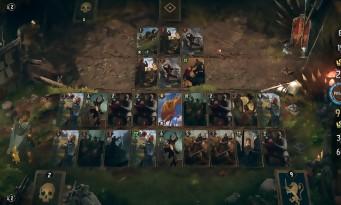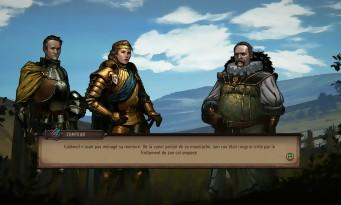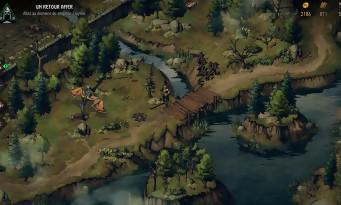 Formerly linked to a secondary quest of The Witcher 3, the card game Gwent has recently been declined in free-to-play multiplayer. Thronebreaker: The Witcher Tales, as its name does not suggest at all, is in a way a single-player and paid version of Gwent. Solo version which still has a multiplayer menu… which actually launches Gwent. The separation between the two games is therefore quite blurred, and it is legitimately difficult to find your way around. But let's skip over these structural and communication issues to get to the game itself. As its name suggests this time, the universe used is that of The Witcher. The scenario begins in 1267 and features Meve, queen of the kingdoms of Lyria and Riv, whose legendary beauty will soon experience setbacks, the second war against Nilfgaard leaving her with an ugly scar on her face. We won't reveal anything more to you here, but know that fans of The Witcher will find their favorite universe with great pleasure. The screenplay and the narrative as a whole could have been just an excuse to play a few card games, but CD Projekt RED put their heart into it. The original voices are for example very convincing, unlike the French voices which regularly fall flat. Fortunately, it is possible to choose the audio/subtitle pair you want. The high quality music has nothing to envy to that of a big game. Finally, the writing is as rich as it is interesting. The slightest quest results in full contextualization, and even picking up a simple key can lead you to uncover a moving story in the letter that accompanies the item. Better still, halfway between graphic novel and role-playing game, Thronebreaker will regularly ask you to make choices, either in particular situations or during dialogues. Far from being trivial, your answers are likely to change the course of events.
Formerly linked to a secondary quest of The Witcher 3, the card game Gwent has recently been declined in free-to-play multiplayer. Thronebreaker: The Witcher Tales, as its name does not suggest at all, is in a way a single-player and paid version of Gwent. Solo version which still has a multiplayer menu… which actually launches Gwent. The separation between the two games is therefore quite blurred, and it is legitimately difficult to find your way around. But let's skip over these structural and communication issues to get to the game itself. As its name suggests this time, the universe used is that of The Witcher. The scenario begins in 1267 and features Meve, queen of the kingdoms of Lyria and Riv, whose legendary beauty will soon experience setbacks, the second war against Nilfgaard leaving her with an ugly scar on her face. We won't reveal anything more to you here, but know that fans of The Witcher will find their favorite universe with great pleasure. The screenplay and the narrative as a whole could have been just an excuse to play a few card games, but CD Projekt RED put their heart into it. The original voices are for example very convincing, unlike the French voices which regularly fall flat. Fortunately, it is possible to choose the audio/subtitle pair you want. The high quality music has nothing to envy to that of a big game. Finally, the writing is as rich as it is interesting. The slightest quest results in full contextualization, and even picking up a simple key can lead you to uncover a moving story in the letter that accompanies the item. Better still, halfway between graphic novel and role-playing game, Thronebreaker will regularly ask you to make choices, either in particular situations or during dialogues. Far from being trivial, your answers are likely to change the course of events.
APRÈS THE WITCHER 3, THE WITCHER CARTE !
 Quests, keys to pick up, choice of dialogues… that hardly seems to stick to the definition of a card game. In fact, most of the adventure takes place at the controls of Meve, which is moved freely in the world of The Witcher. The queen can gather resources there (gold, wood, recruits), meet new companions to enlist, carry out main and secondary missions, open chests whose location is indicated by treasure maps, make decisions that will increase or will lower the morale of his army (a parameter taken into account during card games), and even establish a camp. The latter allows him to create new cards, modify his current deck, talk to his companions, and even improve various abilities, such as his speed of movement in the world for example. But in the end, all these elements remain at the service of the card games themselves. Based on the Gwent, these offer two different lines on which to place the cards, one symbolizing close combat and the other ranged combat. Overall, the game differs quite a bit from classic card games. The big Hearthstone players will therefore have to lose some reflexes and acquire others if they want to get out of it. Thus, you can only play one card per turn, the units cannot attack by default, and victory is simply obtained by accumulating the greatest number of strength points in total, therefore by placing a maximum of powerful cards in the field. Heroic abilities of army leaders, units with a deploy action, those that can apply orders, the effect of weather cards on entire lines or even the need to win three rounds with the same set of cards give rise to the final to very strategic parts. Typically, we can be led to voluntarily lose a round, in order to keep some important cards under the elbow for the next one.
Quests, keys to pick up, choice of dialogues… that hardly seems to stick to the definition of a card game. In fact, most of the adventure takes place at the controls of Meve, which is moved freely in the world of The Witcher. The queen can gather resources there (gold, wood, recruits), meet new companions to enlist, carry out main and secondary missions, open chests whose location is indicated by treasure maps, make decisions that will increase or will lower the morale of his army (a parameter taken into account during card games), and even establish a camp. The latter allows him to create new cards, modify his current deck, talk to his companions, and even improve various abilities, such as his speed of movement in the world for example. But in the end, all these elements remain at the service of the card games themselves. Based on the Gwent, these offer two different lines on which to place the cards, one symbolizing close combat and the other ranged combat. Overall, the game differs quite a bit from classic card games. The big Hearthstone players will therefore have to lose some reflexes and acquire others if they want to get out of it. Thus, you can only play one card per turn, the units cannot attack by default, and victory is simply obtained by accumulating the greatest number of strength points in total, therefore by placing a maximum of powerful cards in the field. Heroic abilities of army leaders, units with a deploy action, those that can apply orders, the effect of weather cards on entire lines or even the need to win three rounds with the same set of cards give rise to the final to very strategic parts. Typically, we can be led to voluntarily lose a round, in order to keep some important cards under the elbow for the next one.
THE WITCHER BEWITCHES US
 But all this, the Gwent free-to-play already offered us its interpretation. Solo adventure requires, Thronebreaker is not content to align endless standard matches. Many quests can only be solved by winning "puzzles". This term refers to games offering special rules and predefined decks. We must then completely rethink our way of playing and, often, go about it several times before finding the right combination of cards and movements to fulfill the objectives requested. Much like the entire adventure portion of the game, these card-based puzzles really set Thronebreaker apart from Gwent. Proof that we are not dealing with a variation made in a hurry, it takes about thirty hours to reach the end of the epic of Meve. There is therefore not much to reproach the new production of CD Projekt, if not perhaps some wavering in the handling of the heroine in the sets, and graphics which give off a certain charm but lack personality all the same. It is not for nothing that the cel-shading technique has not been in fashion for a few years now. As here, it too often seems to be an easy solution, even a cover-up. On the other hand, the card illustration visuals are all of high quality. Let's end by saluting the editorial policy of GOG which, as usual, spares us any DRM and offers us tasty digital bonuses, among which we find the original soundtrack in high quality, a The Witcher comic book, a 250-page artbook and … maps for free-to-play Gwent. The circle is complete !
But all this, the Gwent free-to-play already offered us its interpretation. Solo adventure requires, Thronebreaker is not content to align endless standard matches. Many quests can only be solved by winning "puzzles". This term refers to games offering special rules and predefined decks. We must then completely rethink our way of playing and, often, go about it several times before finding the right combination of cards and movements to fulfill the objectives requested. Much like the entire adventure portion of the game, these card-based puzzles really set Thronebreaker apart from Gwent. Proof that we are not dealing with a variation made in a hurry, it takes about thirty hours to reach the end of the epic of Meve. There is therefore not much to reproach the new production of CD Projekt, if not perhaps some wavering in the handling of the heroine in the sets, and graphics which give off a certain charm but lack personality all the same. It is not for nothing that the cel-shading technique has not been in fashion for a few years now. As here, it too often seems to be an easy solution, even a cover-up. On the other hand, the card illustration visuals are all of high quality. Let's end by saluting the editorial policy of GOG which, as usual, spares us any DRM and offers us tasty digital bonuses, among which we find the original soundtrack in high quality, a The Witcher comic book, a 250-page artbook and … maps for free-to-play Gwent. The circle is complete !


























